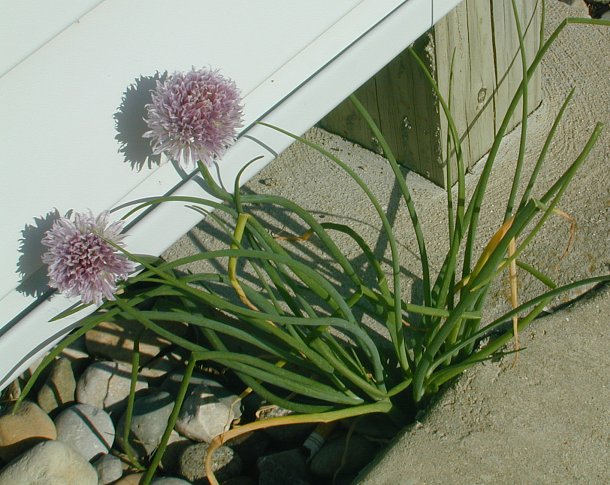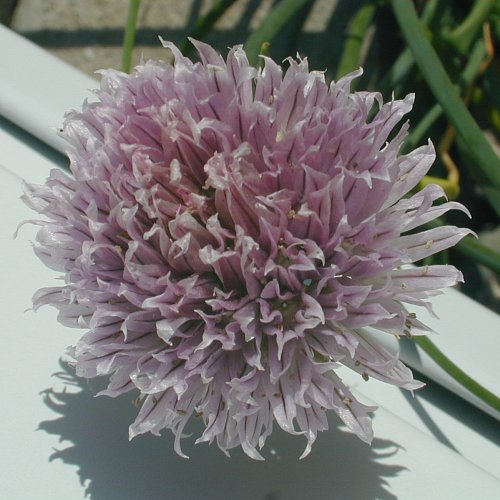Description: This herbaceous perennial plant is 6-20" tall, consisting of a dense tuft of basal leaves from tightly clustered bulbs. The basal leaves are erect, ascending, or arching-spreading; they are medium green, filiform, terete, hollow, glabrous, and sometimes glaucous. One or more flowering stalks develop from within the basal leaves. These stalks are more stiffly erect than the leaves; they are 8-20" long, medium green, filiform, terete, and glabrous. Usually, the stalks are leafless, although on rare occasions 1-2 cauline leaves may develop from an individual stalk. At the apex of each stalk, there is a crowded umbel of 30-50 flowers that spans about 1–1½" across; this umbel is held erect and it is globoid to subgloboid (globoid, but slightly flattened) in shape. Initially, the umbel is enclosed by a pair of membranous spathes with a sheath-like appearance, but the latter shrivel away when the flowers begin to bloom. Each flower is up to 2/3" (15 mm.) long, consisting of 6 pink or lavender tepals, 6 stamens, and a pistil with a single white style. The filaments of the stamens are white, while their anthers are variably colored. The tepals are narrowly elliptic in shape and strongly ascending; they often have fine lines of purple where their midribs occur. The style has a knobby tip. At the bases of these flowers, there are short pedicels up to ¼" long; these pedicels are largely hidden by the flowers when the latter are in bloom. Both the foliage and flowers have a mild onion-like aroma. The blooming period occurs from late spring to early summer, lasting about 3-4 weeks. Afterwards, individual flowers are replaced by 3-valved seed capsules (3-4 mm. across) that split open to release their seeds. These seeds are 2–2.5 mm. (less than 1/8") in length with a 3-angled ellipsoid shape; 2 sides of each seed are flat, while the remaining side is curved. In addition, the seeds are black, somewhat wrinkled, and glabrous. The root system consists of slender bulbs that are ellipsoid in shape and up to ¾" (20 mm.) in length; these bulbs have fibrous roots underneath. The outermost layers of the bulbs are brown and membranous. Clonal offshoots are created by the formation of new bulbs in the ground. This plant also reproduces by reseeding itself. The leaves die down during the winter.

Cultivation:
The preference is full or partial sun, moist to mesic conditions, and a
fertile loamy soil. Chives is winter-hardy and easy to cultivate.
Range & Habitat:
As a wild plant, Chives has naturalized in only a few counties of
Illinois (see Distribution
Map), where it is uncommon. While it is
native to boreal areas of both Eurasia and North America, Chives was
introduced into Illinois as a culinary herb. It is still commonly
cultivated in gardens, from where this plant occasionally escapes.
Habitats include grassy areas along railroads and roadsides, areas that
are adjacent to gardens, weedy meadows, banks of streams, and waste
areas. Habitats with a history of disturbance are preferred. Chives is
less aggressive than either Allium
vineale (Field Garlic) and Allium
canadense (Wild Garlic).
Faunal Association:
The nectar and pollen of the flowers attract small bees and flower
flies primarily. Some insect species are known to feed destructively on
Chives (Allium
schoenoprasum) and other Allium spp. Insects
that feed on the foliage and/or flowers include Thrips tabaci
(Onion Thrips), Myzus
ascalonicus (Shallot Aphid), Neotoxoptera formosa
(Onion Aphid), Lindbergocapsus
allii (Onion Plant Bug), and Lindbergocapsus ainsliei;
see Marshall (2006), Blackman & Eastop (2013), Knight (1941),
and
Henry (1982). The larvae of several insects also feed on the bulbs of
these plants, including Strigoderma
arbicola (False Japanese Beetle), Delia antiqua
(Onion Maggot), Tritoxa
flexa (Black Onion Fly), Eumerus strigatus
(Onion Bulb Fly), and Eumerus
tuberculatus
(Lesser Onion Bulb Fly). Mammalian herbivores usually avoid consumption
of the foliage of Chives and other
Allium spp., although it is
occasionally consumed by White-tailed Deer and domesticated cattle
(Sotala & Kirkpatrick, 1973; Georgia, 1913), especially during
the
spring when little else is available. When dairy cattle consume these
plants, this taints the flavor of milk that they produce.

Photographic
Location:
Along a sidewalk at the webmaster's apartment complex. This plant was
established from seed that had blown across the sidewalk from a
neighboring pot of herbs.
Comments:
The chopped leaves of Chives has a mild onion flavor that can be used
to season various dishes and sauces, including salads and sour cream.
The umbels of flowers are also edible if they are picked while they are
still young; like the leaves, they have an onion flavor. This plant is
rich a source of antioxidants, especially the leaves (Stajner et al.,
2004). It also contains significant amounts of Vitamin A (as
beta-carotene), folic acid, Vitamin C, Vitamin K, protein, and other
nutrients. Chives (Allium
schoenoprasum) is fairly easy to distinguish from other Allium spp.
cause of its dense umbels of flowers and dense tufts of very narrow
leaves. The umbels of other Allium
spp. are typically more loose and
there are conspicuous gaps between their flowers. The basal
leaves of other Allium
spp. are either solid and flattened or they are more terete
and hollow. If they are the latter, then
they are somewhat broader in circumference at their bases than the
leaves of chives. Chives doesn't
produce aerial bulblets, whereas Allium vineale
(Field Garlic), Allium canadense (Wild Garlic), and
some cultivated Allium
spp.
almost always do. Two varieties of Chives are sometimes described: the
typical variety and var.
sibiricum. The latter tends to be a taller and
more robust plant, otherwise these two varieties are very similar to
each other and they have a tendency to intergrade.